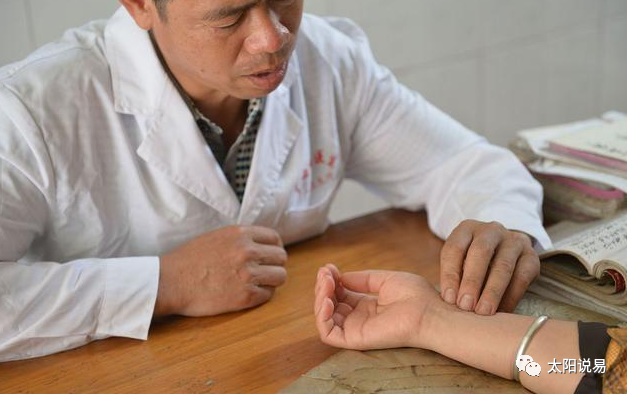
In Traditional Chinese Medicine (TCM), pulse diagnosis often employs three different levels of pressure to assess the pulse quality: light pressure on the skin is termed “floating” (jǔ), heavy pressure down to the bones is termed “deep” (àn), and moderate pressure to the muscles is termed “moderate” (xún).

The floating pulse is characterized by a strong heartbeat felt with light pressure, while heavy pressure may reveal a slight deficiency in strength but not emptiness. The “Pulse Classic” states: “The floating pulse is strong when lifted and weak when pressed.” It lies on the surface of the skin, easily felt with a gentle touch, akin to a light breeze ruffling the feathers on a bird’s back, fluffy and light. The “Suwen” states: “Like tracing the elm seeds.” This means it feels as gentle as lightly touching a string of elm seeds. Many ancient scholars have used various metaphors, such as water floating on wood or twisting scallion leaves.

The formation of the floating pulse is often due to the invasion of external pathogens affecting the skin, where the body’s defensive Yang energy resists these pathogens, causing the righteous Qi to rise and the Yang energy to float, resulting in a floating pulse. As stated in the “Three Essentials of Diagnosis”: “Floating corresponds to the response of the meridians and skin, primarily due to the invasion of external pathogens into the three Yang meridians, causing the pulse Qi to surge outward, hence the floating fullness felt at the fingertips.” When external pathogens invade, the body’s righteous Qi rises to resist them. Naturally, individual constitution varies; those with strong righteous Qi exhibit a strong pulse, while those with weak righteous Qi show a weak pulse. When the body’s righteous Qi is excessively released outward, the Qi and blood flow rapidly outward and upward, pushing the radial artery to rise and float, which is the sensation of a floating pulse. Modern medicine interprets the floating pulse as a strong heartbeat, increased blood flow, and expanded blood vessels, leading to elevated pulse pressure. When moderate or heavy pressure is applied, the local radial artery lumen narrows due to external pressure, increasing vascular resistance and reducing pulse pressure, hence the gradual weakening of the pulse.

TCM emphasizes the balance of Qi and blood, Yin and Yang, and the concepts of deficiency and excess. If a floating pulse is observed in a new illness, it often indicates an invasion of external pathogens, with the defensive Yang vigorously resisting the pathogens, causing Qi to surge to the surface, accompanied by blood. However, a floating pulse can also be seen in chronic illnesses, where it is characterized by being floating without root, large but weak. The underlying cause is a significant deficiency of Yin blood, where Yin fails to restrain Yang, leading to unregulated Yang energy floating outward, resulting in a weak and scattered pulse. As noted in the “Three Essentials of Diagnosis”: “If the pulse is floating after a long illness, it indicates a deficiency of internal Qi that cannot be contained.” This pulse pattern signifies a weakened body, low resistance, and a severely weakened heart, indicating a precursor to the loss of Yang energy.

The floating pulse is relatively shallow, representing lightness and emptiness above, hence it symbolizes the heavens. The floating pulse is a Yang pulse, corresponding to the Qian hexagram in the I Ching, which represents pure Yang, and in the Five Elements, it belongs to Metal. The lungs, being the “crown” of the five organs, belong to Metal and are light and empty in nature. Therefore, the floating pulse in the human body is associated with the lungs. In autumn, as the Yang energy in nature begins to gather, the human body’s Yang energy also responds accordingly, leading to a relative weakening of the pulse’s striking force compared to summer, manifesting on the skin. This reflects the physiological transition of Yang diminishing and Yin increasing within the body, hence a floating pulse in autumn is often viewed as a normal pulse, typically ranging from four to five beats.

From the above analysis, the floating pulse is generally seen in exterior syndromes and also in cases of floating Yang excess. The floating pulse indicates an exterior syndrome, which can be further classified into deficiency or excess. A floating pulse with strength indicates an exterior excess syndrome, while a floating pulse without strength indicates an exterior deficiency syndrome. Of course, a floating pulse can also represent a heat syndrome, but in this case, it is due to external heat surging outward, resulting in a strong floating pulse. As stated in the “Treatise on Cold Damage”: “Floating pulse, fever, dry mouth, dry nose…” This describes the heat excess in the Yangming Qi level, where the heat pathogen disturbs the blood level, causing both Qi and blood to be scorched, thus leading to a floating pulse. There are many examples in the “Treatise on Cold Damage” that illustrate this, but understanding the concept is sufficient. A strong floating pulse often indicates wind-heat, while a weak floating pulse suggests blood deficiency. The floating pulse is primarily observed at the cun position and is often associated with headaches and dizziness, or may indicate the accumulation of wind-phlegm in the chest. If a floating pulse is felt at the guan position, a floating left guan indicates excess liver Yang, while a floating right guan indicates weakened spleen Qi. A floating pulse at both chi positions suggests insufficient kidney Qi, which may lead to urinary difficulties.

The floating pulse is indicative of exterior conditions, and due to the different nature of the invading pathogens, it can manifest as cold damage, wind-heat, or wind-dampness, all of which can present with a floating pulse. However, the accompanying pulse characteristics differ: a floating pulse with rapid beats indicates wind-heat, a floating pulse with tightness indicates wind-cold, a floating pulse with slowness indicates wind-dampness, a floating pulse with weakness indicates heat due to blood loss, and a floating pulse with flooding indicates deficiency heat, which is weak upon pressure, often due to both Qi and blood deficiency, leading to the outward display of Yang energy. A floating pulse that is scattered indicates exhaustion, with a weak and disordered pulse, requiring urgent administration of Sheng Mai San to stabilize the critical condition. In cases of Qi deficiency and fluid damage, a floating pulse may also be accompanied by a rough pulse. Of course, aside from the normal floating pulse in autumn, which should be four to five beats, generally, the floating pulse does not adhere to the prescribed number of beats and may coexist with rapid, slow, or other pulse types.

In the “Gynecology of Fu Qingzhu”, there is a formula that uses neutralizing herbs, which surprisingly has remarkable effects.
Li Dongyuan’s formula is effective for strengthening the spleen, benefiting Qi, warming the stomach, and alleviating pain.
There is a type of headache known as “heat-induced headache”; I wonder how much you know about it.
Li Dongyuan’s formula, although related to the diseases of the five organs and nine orifices, is also connected to the internal organs.
Li Dongyuan’s formula does not contain Qi-regulating herbs; why is it named “Guiding Qi”?
With damp-heat accumulating internally and insufficient spleen and stomach, Li Dongyuan’s formula is indeed trustworthy.

